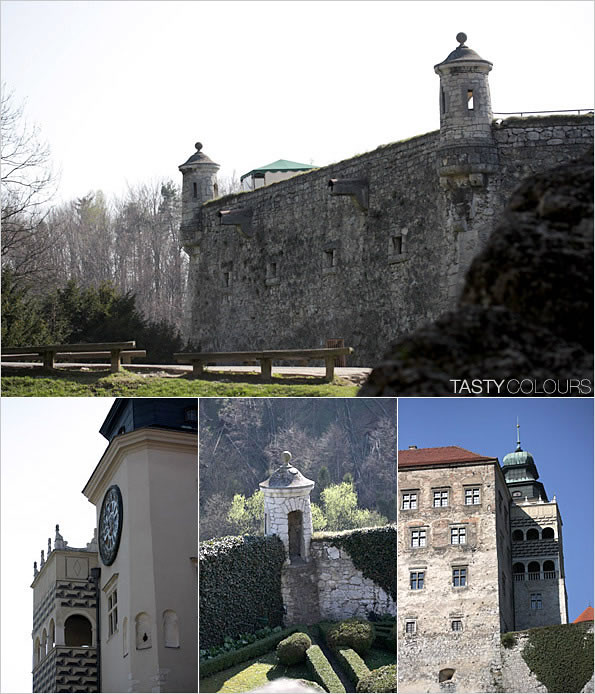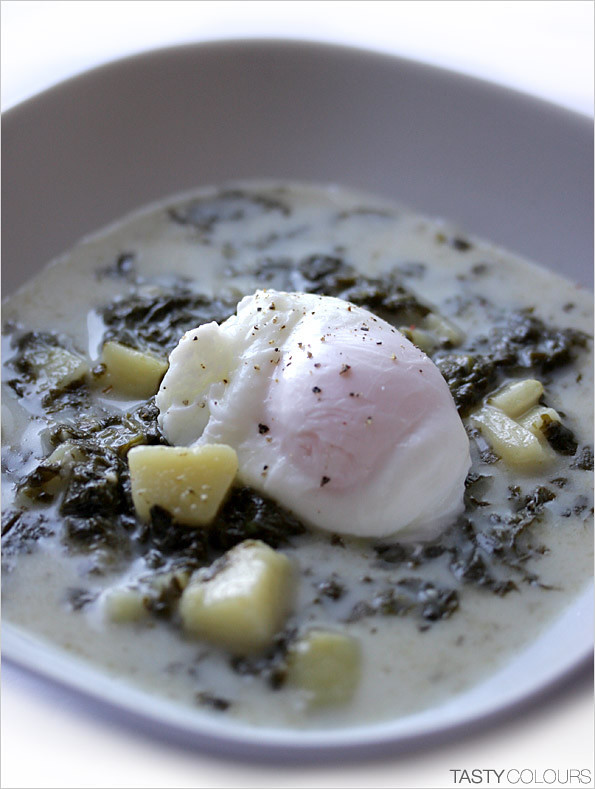So. Italians have their World famous Caprese. This little salad is also popular in Poland and commonly served as a starter in thousands of Polish restaurants, not only those specializing in Italian food. The salad is usually served with industrial mozzarella produced by huge international companies. Its texture resembles chewing gum. And it is tasteless. People who know Italy say that fresh mozzarella is good only there; it hates transportation, and should not be stored for a long time (and this one we can buy here in Poland has a long shelf life; of course, I buy it to use it in pizza or toasts, but I avoid eating it in salads).
Why, instead of those poor imitations of Italian food, something simple with fresh local and seasonal products cannot be found easily in our foodie places? Ok, I saw a Polish style caprese once – around 10 years ago in one of Kraków’s resto-bars. And I do not know if it is still served there, because I do not go there anymore (but I will check it out, especially for you).
A Polish version of caprese could be prepared, for example, with some local cheeses such as “bundz” - from the south of Poland, which I already presented a few times on my blog. The season for bundz already started in May. Another cheese called “koryciński” from the eastern part of the country (it is already sold in Kraków, for example on Kleparz market) or just fresh-home made tvarog, the most popular Polish cheese.
So, those cheeses may be accompanied by tomatoes, fresh herbs like thyme or basil, olive oil or … Polish artisanal and organic oil made from plants that grow in Poland: for example: cold – pressed linen oil (remember that cold pressed linen oil should not be used for frying and it should be used within a few weeks after opening of the bottle) or erucic-acids free cold-pressed organic colza oil, which is extremely healthy (sometimes called the “olive oil” from the North) – still not popular, but both available in good stores carrying organic food. The flavor of those two oils is particularly strong; if one does not like it, just use olive oil et voila!
Tvarog is a fresh curd cheese made from cow’s milk. I remember from my childhood how my mom made it during our holidays in the countryside. In those times, access to fresh, raw and non pasteurized milk straight from the cow was not a big deal, like it is nowadays. Even in Kraków, a bottle of fresh, raw milk could be dropped off to your door step every morning. This milk was delivered, I remember, by an athletic and bearded guy who had a habit to climb the stairs with the speed of light (probably training for some sort of a sport). He always sweated like a pig. So, coming back to tvarog - it was traditionally made from warmed, non pasteurized milk “straight from the cow”, which was naturally getting sour. My mom was just leaving this milk in a jar or a stone bowl, then once it became sour (soured milk – “zsiadłe mleko”, “kwaśne mleko” is a sort of a popular drink in Poland), it was poured into a linen cornet and placed in a press (one can just use a stone or something heavy) to eliminate the whey (runny leftover liquid after curding the cheese) and to shape it as a triangle with oval edges.
Tvarog has a bit of a dry texture; it may be sliced, crumbled, whipped with cream or yoghurt, mixed with fresh chopped herbs and veggies, etc. It is used in pastries - for cheesecakes, in cooking (for example, dumplings – pierogi, pancakes (“naleśniki”), and sandwich spreads. It may be eaten in a sweet version with honey, confiture etc.
Some say this cheese is not even worth mentioning, as it is tasteless and worthless. I am not quite convinced. Good quality, or home made tvarog can be delicious; it just needs a little accompaniment, like a slice of bread with a crispy crust, salt, pepper, herbs etc.
Tvarog, in its various versions (full fat, medium fat, light) is usually sold in blocks (one can also buy grind tvarog in plastic boxes). Unfortunately, as food in Poland becomes more and more industrialized, it is not so easy to find one of a good quality.
The French do not know tvarog. They do know how to prepare “fromage frais” which is different from tvarog and which cannot be used in Polish cooking (as it is too liquid). One Tvarog I found in a Polish store in Paris was not good (with a shelf life of 3 weeks). As a result, when I was in Paris, I started to experiment with home – made tvarog. I used tens of recipes (some using milk only, another adding yoghurt, kefir, cream, butter milk). There are hundreds of recipes for tvarog.
The recipe from my “Parisian period” below is a compilation of various recipes that I found on the web, including Polish Galeria Potraw. What came out of my experience in home preparation of tvarog is that everything counts – the quality of milk (after a few non-satisfying attempts, I found out that the best milk was an organic milk of the great Bernard Gaborit, cream, etc, and nearly every time this cheese came out differently (sometimes more acid, sometimes sweeter) etc. Depending on the volume of milk, the cooking and straining time may quite vary. I like it when it is fattier, so I add cream, but you can easily omit it or replace it by more buttermilk, for example.
Polish Style Caprese
Serves 1
Ingredients:
4 thin slices of fresh bundz cheese, or koryciński cheese (about 100 g); or 4 thin slices of home-made tvarog (recipe below)
1 medium, ripe tomato
A few nice leaves of basil
1-2 tablespoons olive oil (if you have access to organic cold – pressed linen or colza oil, try to replace olive oil by one of the aforementioned)
Salt
Pepper
1 Blanch your tomato in boiling water. Peel it, cut into quarters and remove the seeds.
2 Place slices of cheese onto a plate. Place tomato quarters on top. Pour oil according to your taste; add a bit of salt and quite a lot of pepper. Decorate with basil leaves. Eat immediately and enjoy.
Home Made Tvarog
Makes between 500 g and 550 g (depending on how the cheese will be drained)
Ingredients:
1 liter full fat, non-pasteurized milk (the best is raw, fresh milk to be bought in shops carrying organic food or from “milk-machines”, if you have one in your town/city/village)
1 liter butter milk (most preferably, organic, with no additives)
250 g heavy cream, non pasteurized, of a good quality
125 g natural, non sweetened yoghurt (the best is organic, without any addition of powdered milk)
1 m2 gauze (or cotton diaper)
2 saucepans
Pour milk into a large saucepan and heat slowly until 40 degrees. Switch the heat off.
Pour it in a large bowl (do not use a metal bowl).
Add butter milk, yogurt and 125 g of cream. Mix everything until it is homogenous.
Cover the milk and put aside in a warm place (the desired temperature should be between 20 and 24 degrees) for about 36 hours, or even 48 (depending on the temperature in the kitchen). The liquid should have a sour taste and should thicken.
Once it is soured, add the remaining 125 g of cream and mix delicately.
Delicately pour soured milk into a saucepan.
In a larger saucepan (rather flatter than higher) bring water to a boil.
Then reduce the heat to a minimum, and place the saucepan with milk in the saucepan with boiling water.
Heat the curd delicately, over minimum heat, between 30 to 40 minutes (this is an individual matter, you really have to be careful!).
From time to time, check with a spoon whether any curd has separated from whey, not only at the edge of the saucepan, but also in the middle.
You should be more careful after 25 to 30 minutes of the curding process. The best way is to taste. You should see little curds on top of the saucepan. The curds should be a bit sweet with a rustic sour aftertaste (the taste, however, always depends on the quality of milk, yoghurt and cream) and they cannot be chewy, gummy nor too hard, otherwise the cheese will not be good.
Then prepare a strainer and the gauze.
Place a strainer, covered with a piece of gauze, in a large bowl. Pour delicately the mixture into the strainer. Be careful – from this amount of milk you will obtain about 1.5 liters of fresh whey. You can throw it away, but you might as well drink it cold (as it is supposed to be very healthy), or use it as a base for soups or even in bread baking.
Once you strained your cheese, remove the strainer with the gauze and place it on a plate.
Knot two opposite ends of the gauze (be careful for the cheese not to fall) and hang it over a bowl for draining. Depending whether the texture you want (cottage cheese for tartines or rather hard cheese, for example, to use as a filling for pierogi ruskie), drain the cheese between one hour and 1.5 or even more. You can also place the cheese in gauze between two cutting boards and squeeze it with something heavy.












